 |
American History
Our Lady of Bethlehem - Part III
Carmel Mission, Her Final Home &
Junipero Serra
Marian T. Horvat, Ph.D.
The ship San Antonio, whose passengers included Our Lady of Bethlehem and Fr. Junipero Serra, left San Diego on April 16, 1770 and reached the harbor of Monterey on May 31. Why the Bay had eluded the first scouting expedition of Captain Portolá was a mystery. “The great thing is that we are here,” wrote Fr. Junipero in a letter dated June 13, 1770. (1)
Three days after their arrival, on June 3, the Feast of the Pentecost, the second of the 21 missions founded on the Alta California coastline was founded. In honor of the King’s name saint, it was called the Presidio-Mission San Carlos Borromeo.
A small chapel and altar was erected in the valley and under the landmark oak tree close to the beach, where Vizcaíno’s Carmelites had said Mass 167 years earlier, Fr. Serra officially established the mission. He described the scene:
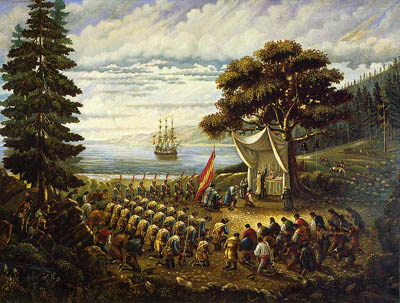
Monterey is founded on Pentecost Sunday June 3, 1770 |
"Everyone arrived singing, while the bells hung from the old oak tree were ringing at full peal. … With all the men kneeling before the altar, we sang the Veni Creator. A large cross had been laid out on the ground; we lifted it together and planted it upright in the earth. I said the prayers for its blessing, and everyone knelt to venerate it. Then I sprinkled holy water over the ground around the cross. At each new act, the bells would ring, the soldiers would fire their guns, and the San Antonio would discharge a volley from its cannon.
“After raising aloft the standard of the King of Heaven, we unfurled the flag of our Catholic Monarch. As we raised each of them we shouted, 'Long live the Faith! Long live the King!' …
“After that ceremony, I began the High Mass, with a sermon after the Gospel, and as long as the Mass lasted, it was accompanied with many salvos of cannon. The Mass ended, I took off my chasuble, and all together we sang in Spanish the Salve Regina in front of the wonderful statue of Our Lady of Bethlehem, which was on the altar. The Most Illustrious Inspector General [Galvez] had given us the statue for this celebration, but with the obligation of returning it to him afterwards, as I will do when the boat sails [to return to Mexico with news of the success].
“At the conclusion of the ceremony, standing up I intoned the Te Deum laudámus. We sang it slowly and solemnly right to the end, with the responses and prayers to the Most Holy Trinity, to Our Lady, to the Holy Saint Joseph, patron of the expedition, to San Carlos, patron of this port, presidio and mission, and finally the prayer of thanksgiving. May God be thanked for all things!” (2)
Our Lady leaves Monterey
One part of Our Lady’s story almost forgotten today is how she left the newly established Monterey Mission, only to return to re-occupy this land she claimed as hers. The statue belonged to Inspector General José de Galvez, on loan to the friars to protect the Sacred Expedition and insure the successful founding of the Monterey Presidio-Mission. She was present when the first mission of San Diego was established; afterward for almost a year she was there on its altar for all the Masses and daily prayers. Now she had entered Monterey triumphantly as La Conquistadora – the one who conquers.
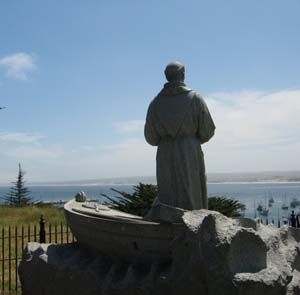
The Serra Monument overlooking the Pacific commemorates the landing in 1770 |
She presided at one more ceremony before her departure. In their first rough church, the Monterey group – consisting of approximately 40 persons – celebrated the Feast of Corpus Christi on June 14. The silver candelabras donated by Galvez were carried in a procession with Captain Portolá marching at its head and the soldiers following in two ranks. Hymns were sung and the cannons thundered anew.
The beautiful statue of Our Lady of Bethlehem occupied the space directly above the monstrance of her Most Holy Son, standing guard over the church.
“Everything was carried out with such splendor that it might have been gazed upon with delight even in Mexico,” wrote Fr. Serra to Galvez. (3)
“And now that she has occupied Monterey with us,” he continued, “I am going to send you back your Madonna, as I promised you at La Paz. Tomorrow we shall bid her farewell by singing the Mass before her for the last time.” (4)
On July 3, 1770, the statue of Our Lady of Bethlehem sailed on the departing San Antonio to be returned to Inspector General Gálvez in Mexico City.
The Virgin returns to stay at Carmel Mission
Shortly Galvéz was announcing to the world that the Franciscans were holding religious processions north of the 36th parallel and that these new provinces were annexed to the Spanish Empire. Enthusiasm ran high – New Spain was larger by a 750-mile coast, a feat accomplished by a small troupe of soldiers and a handful of friars. The cannons of Mexico City thundered and the Cathedral bells rang out, answered by bells of monasteries and churches over the city. The hero of the day was Galvez.
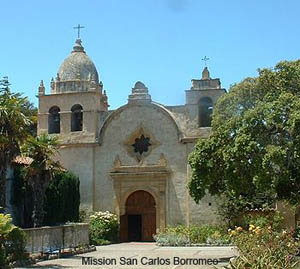
Mission San Carlos Borromeo in Carmel-by-the-Sea, restored in the last century |
Report of the Monterey expedition circulated throughout Europe, reaching the courts of Catherine the Great and the King of England, who were notified as quickly as possible that Spain was now solidly established in Alta California.
Two years later, Gálvez returned in triumph to Spain, where King Charles III made him Marqués de Sonora and appointed him Minister of the Indies. But before he left the New World, he determined to send the statue of Our Lady of Bethlehem back to Mission San Carlos, which had been moved to Carmel, about five miles south of Monterey.
To remove the Indians from the bad influence of the soldiers and to avoid a hostile new Commander, Fr. Serra judged it opportune to separate the Mission from the Presidio. In December 1771 the whole Mission establishment was set up on the banks of the Carmel River and in view of the sea. After the move to Carmel, the Indians began to frequent the Mission, and by the end of 1773 Fr. Serra reported more converts there than any mission.
To this “truly delightful spot,” as Fr. Serra described it, Our Lady returned to Alta California to continue her work of conversion and protection. Henceforth, the Carmel Mission became the home and headquarters of both the Virgin of Bethlehem and Fr. Serra.
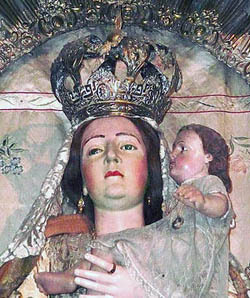
The silver crown, an ex voto offering of a Captain saved at sea by Our Lady |
As Father General of Alta California, Fr. Serra often traveled the Camino Real that led from San Diego to the San Francisco area, a distance of 700 miles. He personally founded nine of the 21 missions that were eventually established. But he always returned to Carmel and his beloved Virgin. This was the place dearest to his heart, with its twisted cypress and rocks jutting up from the sea, recalling memories of the Island of Mallorca in Spain where he was born.
Having recourse to Nuestra Señora de Belen became a custom of the captains and sailors who sailed the waters of California. In letters dated May 1774, June 1774, October 1775, and July 1779, Fr. Serra makes mention of special Masses he said to fulfill the promises of sailors who had asked the protection of Nuestra Senora de Belén in times of peril. (5) In December 1802, the Commander of the frigate Most Pure Conception would give Our Lady a silver crown in thanksgiving for saving his ship on a dangerous voyage, showing this tradition continued into the 19th century.
Fr. Serra’s death
On August 27, 1784, Fr. Serra asked to be taken to chapel where his beloved statue of the Virgin of Bethlehem presided. He was very weak and knew he was dying, but he insisted on reciting prayers with the neophyte Indians, concluding with the hymn that Ven. Fray Margil had composed in honor of the Assumption of Our Lady. Then he received Holy Communion and took his leave of the Virgin who had conquered the land.
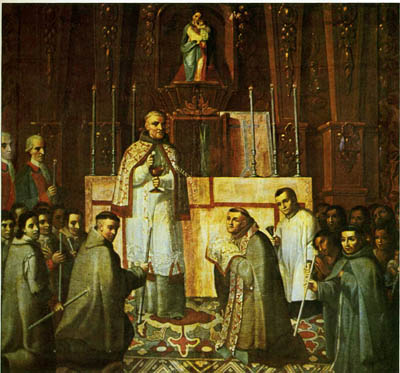
Fr. Serra' Viaticum - He is kneeling at right, wearing a stole |
The next day, he died in his cell holding the crucifix that he had received in his novitiate and had carried on all his travels. He was 70 years old.
Shortly after Fr. Serra's death, Fr. Francisco Palóu, the new Father General of the Missions, wrote to the Franciscan College in Mexico City asking that Fr. Serra be memorialized in a painting commemorating his last Viaticum. He should be “kneeling and before the altar of Our Lady of Bethlehem with the Child in her arms,” Fr. Palou specified. It is the memorial Fr. Serra would have desired, he added.
The Guardian approved the idea, and the painting titled Fr. Serra’s Viaticum was made. As you can see above right, the priest giving him the viaticum – Fr. Palou – is vested in a cope, stole and surplice over his habit, holding the Host and ciborium. Fr. Serra kneels to the right wearing a stole over his Franciscan habit, holding the Communion veil to catch any particles that might fall from the Host. Around him are soldiers, sailors and Indians holding lighted candles.
Over the open tabernacle with the crucifix on top is the statue of Our Lady of Bethlehem, who was with him when he established his first Mission in Alta California and remained with him to the end.
1, Omer Englebert, The Last of the Conquistadors, Junipero Serra 1713-1784, NY: Harcourt Brace, 1956, p.88
2. Martin Morgado, Junípero Serra’s Legacy, Pacific Grove, CA: Mount Carmel, 1987, pp. 41-42
3. Ibid., p. 44
4. Englebert, The Last of the Conquistadors, pp. 89-90
5. Morgado, Junipero Serra’s Legacy, pp. 45-46
6. “ Blessed Serra’s Devotion to Our Holy Mother,” Siempre Adelante, Spring Summer 2003.
7 Morgado, Junipero Serra’s Legacy,
p. 47
8. Ibid., pp. 93-95
Continued

Posted October 7, 2011

Related Topics of Interest
 Our Lady of Bethlehem: Her Adventure in America Our Lady of Bethlehem: Her Adventure in America
 Our Lady of Bethlehem Begins to Conquer California Our Lady of Bethlehem Begins to Conquer California
 Ven. Antonio Margil, Apostle of Texas Ven. Antonio Margil, Apostle of Texas
 La Conquistadora: Our Country's Oldest Madonna La Conquistadora: Our Country's Oldest Madonna
 The Burning of the Ursuline Convent in Charlestown The Burning of the Ursuline Convent in Charlestown
 Let None Dare Call It Liberty Let None Dare Call It Liberty
 Mary of Agreda in America Mary of Agreda in America

Related Works of Interest
|
|
History | Home | Books | CDs | Search | Contact Us | Donate

© 2002-
Tradition in Action, Inc. All Rights Reserved
|
 |
|